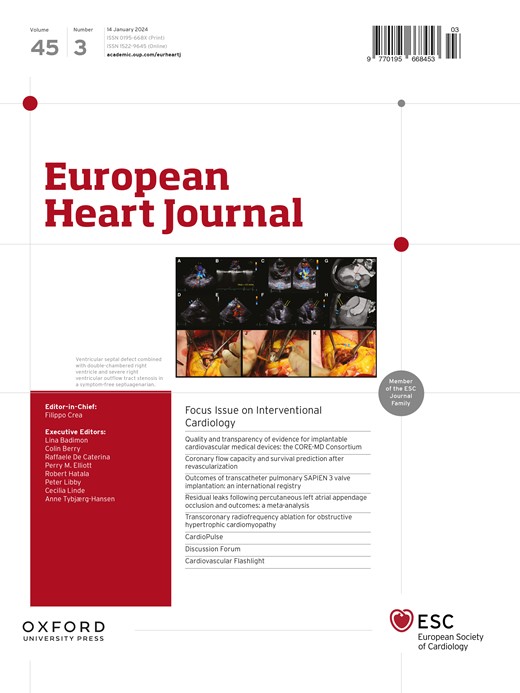Shear stress-induced endothelial HEG1 signalling regulates vascular tone and blood pressure.
IF 35.6
1区 医学
Q1 CARDIAC & CARDIOVASCULAR SYSTEMS
引用次数: 0
Abstract
BACKGROUND AND AIMS Endothelial cells (ECs) sense flow shear stress for vasodilation, a crucial mechanism for maintaining systemic blood pressure (BP). Impaired shear stress signalling contributes to endothelial dysfunction and hypertension. Heart development protein with EGF-like domain 1 (HEG1), a flow-sensitive, endothelial-derived protein, is inversely associated with cardiovascular risks. This study aimed to elucidate the role of endothelial HEG1 in BP regulation and the underlying mechanisms. METHODS Phenome-wide association study, computational fluid dynamics analysis, single-cell RNA sequencing, artery and plasma samples from independent cohorts, and in vitro shear stress analysis were used to assess the association between hypertension, shear stress, and HEG1 levels. Endothelial-specific Heg1 deletion mice, BP monitoring, and vascular function analysis were employed to characterize the roles of EC-HEG1 in endothelial function and hypertension. Proteomics, transcriptomics, and ubiquitination assays were used to identify the regulatory pathways involved. RESULTS Plasma HEG1 levels were down-regulated in hypertensive subjects due to reduced wall shear stress on the endothelium, which diminished HEG1 expression and its release into circulation. Endothelial-specific Heg1 deletion in mice resulted in elevated BP, impaired endothelium-dependent vasodilation, and hypertensive levels especially in an ApoeKO dyslipidaemia background. Mechanistically, HEG1 facilitated CUL3-mediated degradation of PHACTR1. HEG1 deletion led to increased PHACTR1 levels, nuclear translocation, and suppression of SP1-mediated eNOS transcription and NO production. Inhibition of PHACTR1 nuclear localization by CCG-1423 prevented impaired vasodilation and hypertension. CONCLUSIONS Our study identifies a novel shear-sensitive endothelial HEG1 signalling pathway in BP regulation, providing potential therapeutic targets for hypertension.剪切应力诱导的内皮细胞HEG1信号调节血管张力和血压。
内皮细胞(ECs)感知血流剪切应力以实现血管舒张,这是维持全身血压(BP)的关键机制。剪切应力信号的受损会导致内皮功能障碍和高血压。具有egf样结构域1的心脏发育蛋白(HEG1)是一种血流敏感的内皮源性蛋白,与心血管风险呈负相关。本研究旨在阐明内皮细胞HEG1在血压调节中的作用及其机制。方法采用全基因组关联研究、计算流体动力学分析、单细胞RNA测序、独立队列的动脉和血浆样本以及体外剪应力分析来评估高血压、剪应力和HEG1水平之间的关系。采用内皮特异性Heg1缺失小鼠、血压监测和血管功能分析来表征EC-HEG1在内皮功能和高血压中的作用。蛋白质组学、转录组学和泛素化分析被用来确定所涉及的调控途径。结果高血压患者血浆HEG1水平下调是由于内皮细胞壁面剪切应力减少,导致HEG1表达减少,HEG1进入循环的释放减少。内皮特异性Heg1缺失导致小鼠血压升高,内皮依赖性血管舒张功能受损,特别是ApoeKO血脂异常背景下的高血压水平。在机制上,HEG1促进了cul3介导的PHACTR1降解。HEG1缺失导致PHACTR1水平升高,核易位,抑制sp1介导的eNOS转录和NO产生。CCG-1423抑制PHACTR1核定位可防止血管舒张受损和高血压。结论我们的研究发现了一种新的剪切敏感内皮细胞HEG1信号通路在血压调节中,为高血压的治疗提供了潜在的靶点。
本文章由计算机程序翻译,如有差异,请以英文原文为准。
求助全文
约1分钟内获得全文
求助全文
来源期刊

European Heart Journal
医学-心血管系统
CiteScore
39.30
自引率
6.90%
发文量
3942
审稿时长
1 months
期刊介绍:
The European Heart Journal is a renowned international journal that focuses on cardiovascular medicine. It is published weekly and is the official journal of the European Society of Cardiology. This peer-reviewed journal is committed to publishing high-quality clinical and scientific material pertaining to all aspects of cardiovascular medicine. It covers a diverse range of topics including research findings, technical evaluations, and reviews. Moreover, the journal serves as a platform for the exchange of information and discussions on various aspects of cardiovascular medicine, including educational matters.
In addition to original papers on cardiovascular medicine and surgery, the European Heart Journal also presents reviews, clinical perspectives, ESC Guidelines, and editorial articles that highlight recent advancements in cardiology. Additionally, the journal actively encourages readers to share their thoughts and opinions through correspondence.
 求助内容:
求助内容: 应助结果提醒方式:
应助结果提醒方式:


